Topic: The use of optical devices in medicine. Simple optical instruments
Simple optical devices.
magnifying glass
One of the simplest optical instruments is a magnifying glass - a converging lens designed to view enlarged images of small objects. The lens is brought close to the eye itself, and the object is placed between the lens and the main focus. The eye will see a virtual and enlarged image of the object. It is most convenient to examine an object through a magnifying glass with a completely relaxed eye, accommodated to infinity. To do this, the object is placed in the main focal plane of the lens so that the rays emerging from each point of the object form parallel beams behind the lens. The figure shows two such beams coming from the edges of the object. Getting into the eye accommodated to infinity, beams of parallel rays are focused on the retina and give a clear image of the object here.
The simplest instrument for visual observation is a magnifying glass. A magnifying glass is a converging lens with a short focal length. The magnifying glass is placed close to the eye, and the object under consideration is in its focal plane. The object is seen through a magnifying glass at an angle.
where h is the size of the item. When viewing the same object with the naked eye, it should be placed at the distance of the best view of the normal eye. The object will be visible at an angle
It follows that the magnification of the magnifying glass is
A lens with a focal length of 10 cm gives a magnification of 2.5 times.
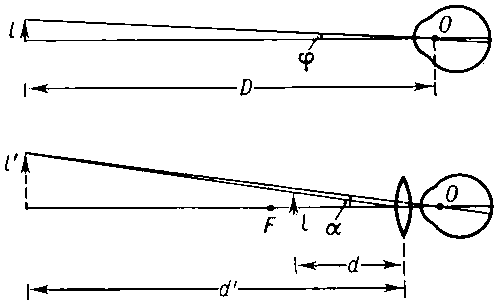
Fig 3. 1 Magnifying glass action: a - the object is viewed with the naked eye from the distance of best vision; b - the object is viewed through a magnifying glass with a focal length F.
Angular magnification
The eye is very close to the lens, so the angle of view can be taken as the angle 2β formed by the rays coming from the edges of the object through the optical center of the lens. If there were no magnifying glass, we would have to place the object at the distance of best vision (25 cm) from the eye and the angle of view would be 2γ. Considering right triangles with legs 25 cm and F cm and denoting half of the object Z, we can write:
![]() (3.4)
(3.4)
2β - angle of view, when viewed through a magnifying glass;
2γ - angle of view, when viewed with the naked eye;
F - distance from the object to the magnifying glass;
Z is half the length of the subject in question.
Considering that one usually looks through a magnifying glass small parts(and hence the angles γ and β are small), the tangents can be replaced by angles. Thus, we get the following expression for magnifying the magnifying glass:
Therefore, the magnification of the magnifying glass is proportional to, that is, its optical power.
3.2 Microscope .
A microscope is used to obtain large magnifications when observing small objects. An enlarged image of an object in a microscope is obtained using optical system, consisting of two short-focus lenses - an objective O1 and an eyepiece O2 (Fig. 3.2). The lens will give a true inverted magnified image of the subject. This intermediate image is viewed by the eye through an eyepiece, the operation of which is similar to that of a magnifying glass. The eyepiece is positioned so that the intermediate image is in its focal plane; in this case, the rays from each point of the object propagate after the eyepiece in a parallel beam.

The imaginary image of an object viewed through an eyepiece is always upside down. If it turns out to be inconvenient (for example, when reading fine print), you can turn the object itself in front of the lens. Therefore, the angular magnification of the microscope is considered to be a positive value.
As follows from Fig. 3.2, angle of view φ of an object viewed through an eyepiece in the small angle approximation
Approximately, we can put d ≈ F1 and f ≈ l, where l is the distance between the objective and the eyepiece of the microscope (“tube length”). When viewing the same object with the naked eye
As a result, the formula for the angular magnification γ of the microscope becomes
A good microscope can magnify several hundred times. At high magnifications, diffraction phenomena begin to appear.
In real microscopes, the objective and eyepiece are complex optical systems in which various aberrations are eliminated.
Telescope
Telescopes (spotting scopes) are designed to observe distant objects. They consist of two lenses - a converging lens with a large focal length facing the object (objective) and a lens with a short focal length (eyepiece) facing the observer. Spotting scopes are of two types:
1) Kepler's telescope designed for astronomical observations. It gives enlarged inverted images of distant objects and is therefore inconvenient for terrestrial observations.
2) Galileo's spotting scope, intended for terrestrial observations, which gives enlarged direct images. The eyepiece in the Galilean tube is a diverging lens.
On fig. 15 shows the course of rays in an astronomical telescope. It is assumed that the observer's eye is accommodated to infinity, so the rays from each point of a distant object exit the eyepiece in a parallel beam. This course of rays is called telescopic. In an astronomical tube, the telescopic ray path is achieved provided that the distance between the objective and the eyepiece is equal to the sum of their focal lengths.

A spotting scope (telescope) is usually characterized by an angular magnification γ. Unlike a microscope, objects observed through a telescope are always removed from the observer. If a distant object is visible to the naked eye at an angle ψ, and when viewed through a telescope at an angle φ, then the angular magnification is called the ratio
The angular increase γ, as well as the linear increase Γ, can be assigned plus or minus signs, depending on whether the image is upright or inverted. The angular magnification of the Kepler astronomical tube is negative, while that of Galileo's terrestrial tube is positive.
The angular magnification of the telescopes is expressed in terms of focal lengths:
Spherical mirrors are not used as lenses in large astronomical telescopes. Such telescopes are called reflectors. A good mirror is easier to make, and mirrors don't suffer from chromatic aberration like lenses do.
The largest telescope in the world with a mirror diameter of 6 m was built in Russia. It should be borne in mind that large astronomical telescopes are designed not only to increase the angular distances between observed space objects, but also to increase the flow of light energy from faintly luminous objects.
Let us analyze the scheme and principle of operation of some widespread optical devices.
Camera
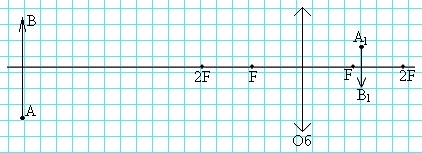
A camera is a device, the most important part of which is a collective lens system - a lens. In ordinary amateur photography, the subject is located behind double the focal length, so the image will be between the focus and double the focal length, real, reduced, inverted (Fig. 16).
| Fig 3. 4 |
A photographic film or photographic plate (covered with a light-sensitive emulsion containing silver bromide) is placed in place of this image, the lens is opened for a while - the film is exposed. A hidden image appears on it. Getting into a special solution - a developer, the "exposed" silver bromide molecules decompose, bromine is carried away into the solution, and silver is released in the form of a dark coating on the illuminated parts of the plate or film; the more light that hits a given area of the film during exposure, the darker it will become. After development and washing, the image must be fixed, for which it is placed in a fixative solution, in which unexposed silver bromide dissolves and is carried away from the negative. It turns out an image of what was in front of the lens, with a rearrangement of shades - the light parts became dark and vice versa (negative).
To obtain a photograph - a positive one - it is necessary to illuminate photographic paper coated with the same silver bromide through the negative for some time. After its manifestation and consolidation, a negative will be obtained from the negative, i.e. a positive, in which the light and dark parts will correspond to the light and dark parts of the object.
To get a high quality image great importance has focusing - combining the image and the film or plate. To do this, old cameras had a movable back wall, instead of a photosensitive plate, a frosted glass plate was inserted; moving the last one, installed by eye sharp image. Then the glass plate was replaced with a photosensitive one and photographs were taken.
Modern cameras for focusing use a retractable lens associated with a rangefinder. In this case, all the quantities included in the lens formula remain unchanged, the distance between the lens and the film changes until it coincides with f. To increase the depth of field - the distances along the main optical axis at which objects are depicted sharply - the lens is apertured, i.e., its aperture is reduced. But this reduces the amount of light entering the apparatus and increases the required exposure time.
The illumination of an image for which the lens is the light source is directly proportional to its aperture area, which, in turn, is proportional to the square of the diameter d2. Illumination is also inversely proportional to the square of the distance from the source to the image, in our case, almost the square of the focal length F. So, the illumination is proportional to the fraction, which is called the aperture ratio of the lens. The square root of the aperture ratio is called the relative aperture and is usually indicated on the lens in the form of an inscription: . Modern cameras are equipped with a number of devices that facilitate the work of the photographer and expand his capabilities (autostart, a set of lenses with different focal lengths, exposure meters, including automatic, automatic or semi-automatic focusing, etc.). Color photography is widespread. In the process of mastering - a three-dimensional photograph.
Eye
The human eye from an optical point of view is the same camera. The same (real, reduced, inverted) image is created on the back wall of the eye - on the light-sensitive yellow spot, in which special endings of the optic nerves - cones and rods are concentrated. Their irritation with light is transmitted to the nerves in the brain and causes the sensation of vision. The eye has a lens - a lens, a diaphragm - a pupil, even a lens cover - an eyelid. In many ways, the eye is superior to today's cameras. It is automatically focused - by measuring the curvature of the lens under the action of the eye muscles, that is, by changing the focal length. Automatically diaphragmed - by constriction of the pupil when moving from a dark room to a light one. The eye gives color image, "remembers" visual images. In general, biologists and physicians have come to the conclusion that the eye is a part of the brain that has been placed on the periphery.
Vision with two eyes allows you to see an object with different parties, i.e. to carry out three-dimensional vision. It has been experimentally proved that when one sees with one eye, the picture from 10 m seems flat (at the base - the distance between the extreme points of the pupil is equal to the diameter of the pupil). Looking with two eyes, we see a flat picture from 500 m (the base is the distance between the optical centers of the lenses), that is, we can determine the size of objects by eye, which and how much closer or further.
To increase this ability, it is necessary to increase the base, this is done in prismatic binoculars and in different kind rangefinders (Fig. 3.5).
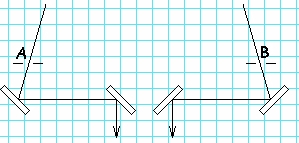
But, like everything in the world, even such a perfect creation of nature as the eye is not without flaws. Firstly, the eye reacts only to visible light (and at the same time, with the help of vision, we perceive up to 90% of all information). Secondly, the eye is subject to many diseases, the most common of which is myopia - the rays converge closer to the retina (Fig. 3.6) and farsightedness - a sharp image behind the retina (Fig. 3.7).

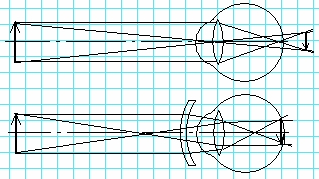
In both cases, an unsharp image is created on the retina. Optics can help these ailments. In case of myopia, it is necessary to choose glasses with concave lenses of the appropriate optical power. With farsightedness, on the contrary, it is necessary to help the eye to bring the rays on the retina, the glasses should be convex and also of the appropriate optical power.
Topics of the USE codifier: optical devices.
As we know from, for a more detailed examination of the object, you need to increase the angle of view. Then the image of the object on the retina will be larger, and this will lead to irritation. more nerve endings of the optic nerve; more visual information will be sent to the brain, and we will be able to see new details of the object in question.
Why is the angle of view small? There are two reasons for this: 1) the object itself is small; 2) the object, although large enough in size, is located far away.
Optical devices - These are devices for increasing the angle of view. A magnifying glass and a microscope are used to examine small objects. To view distant objects, spotting scopes are used (as well as binoculars, telescopes, etc.)
Naked eye.
We start by looking at small objects with the naked eye. Hereinafter, the eye is considered normal. Recall that a normal eye in an unstressed state focuses a parallel beam of light on the retina, and the distance of best vision for a normal eye is cm.
Let a small object in size be at the distance of best vision from the eye (Fig. 1). An inverted image of the object appears on the retina, but, as you remember, this image then turns over again in the cerebral cortex, and as a result, we see the object normally - not upside down.
Due to the smallness of the object, the angle of view is also small. Recall that a small angle (in radians) is almost the same as its tangent: . That's why:
. (1)
If a r distance from the optical center of the eye to the retina, then the size of the image on the retina will be equal to:
. (2)
From (1) and (2) we also have:
. (3)
As you know, the diameter of the eye is about 2.5 cm, so. Therefore, it follows from (3) that when a small object is viewed with the naked eye, the image of the object on the retina is about 10 times smaller than the object itself.
Magnifier.
You can enlarge the image of an object on the retina using a loupe (magnifying glass).
magnifying glass - it's just a converging lens (or lens system); focal length magnifiers usually range from 5 to 125 mm. An object viewed through a magnifying glass is placed in its focal plane (Fig. 2). In this case, the rays emanating from each point of the object, after passing through the magnifying glass, become parallel, and the eye focuses them on the retina without experiencing tension.
Now, as we see, the angle of view is . It is also small and approximately equal to its tangent:
. (4)
The size l images on the retina is now equal to:
. (5)
or, taking into account (4) :
. (6)
As in fig. 1, the red arrow on the retina also points down. This means that (taking into account the secondary reversal of the image by our consciousness) through a magnifying glass we see an unreversed image of the object.
Magnifying glass is the ratio of the image size when using a magnifying glass to the size of the image when viewing an object with the naked eye:
. (7)
Substituting expressions (6) and (3) here, we get:
. (8)
For example, if the focal length of a magnifying glass is 5 cm, then its magnification is . When viewed through such a magnifying glass, an object appears five times larger than when viewed with the naked eye.
We also substitute relations (5) and (2) into formula (7):
Thus, the magnification of a magnifying glass is an angular magnification: it is equal to the ratio of the angle of view when viewing an object through a magnifying glass to the angle of view when viewing this object with the naked eye.
Note that the magnification of a magnifying glass is a subjective value - after all, the value in formula (8) is the distance of the best vision for a normal eye. In the case of a near-sighted or far-sighted eye, the distance of best vision will be correspondingly smaller or larger.
From formula (8) it follows that the magnification of the magnifying glass is the greater, the smaller its focal length. Reducing the focal length of a converging lens is achieved by increasing the curvature of the refractive surfaces: the lens must be made more convex and thereby reduce its size. When the magnification reaches 40-50, the size of the magnifier becomes equal to several millimeters. With an even smaller size of the magnifying glass, it will become impossible to use it, therefore it is considered the upper limit of magnifying glass.
Microscope.
In many cases (for example, in biology, medicine, etc.) it is necessary to observe small objects with a magnification of several hundred. You can't get by with a magnifying glass, and people resort to using a microscope.
The microscope contains two converging lenses (or two systems of such lenses) - an objective and an eyepiece. It's easy to remember: the lens is facing the object, and the eyepiece is facing the eye (eye).
The idea of a microscope is simple. The object in question is between the focus and double focus of the lens, so the lens gives an enlarged (actually inverted) image of the object. This image is located in the focal plane of the eyepiece and then viewed through the eyepiece as if through a magnifying glass. As a result, it is possible to achieve a final increase that is much greater than 50.
The path of the rays in the microscope is shown in Fig. 3.
The designations in the figure are clear: - lens focal length - eyepiece focal length - object size; - the size of the image of the object given by the lens. The distance between the focal planes of the objective and the eyepiece is called tube optical length microscope.
Note that the red arrow on the retina is pointing up. The brain will turn it over again, and as a result, the object will appear upside down when viewed through a microscope. To prevent this from happening, the microscope uses intermediate lenses that additionally flip the image.
The magnification of a microscope is determined in exactly the same way as for a magnifier: . Here, as above, and are the size of the image on the retina and the angle of view when the object is viewed through a microscope, and are the same values when the object is viewed with the naked eye.
We still have , and the angle , as can be seen from Fig. 3 is equal to:
Dividing by , we get to magnify the microscope:
. (9)
This, of course, is not the final formula: it contains and (values related to the object), but I would like to see the characteristics of the microscope. We will eliminate the relation that we do not need using the lens formula.
First, let's take a look at Fig. 3 and use the similarity right triangles with red legs and:
Here is the distance from the image to the lens, - a- distance from object h to the lens. Now we use the lens formula for the lens:
from which we get:
and we substitute this expression in (9) :
. (10)
This is the final expression for the magnification given by the microscope. For example, if the focal length of the lens is cm, the focal length of the eyepiece is cm, and the optical length of the tube is cm, then according to formula (10)
Compare this with the magnification of the lens alone, which is calculated by formula (8) :
The magnification of the microscope is 10 times greater!
Now we move on to objects that are large enough but too far away from us. To view them better, spotting scopes are used - spyglasses, binoculars, telescopes, etc.
The objective of the telescope is a converging lens (or lens system) with a sufficiently large focal length. But the eyepiece can be both a converging and a diverging lens. Accordingly, there are two types of spotting scopes:
Kepler tube - if the eyepiece is a converging lens;
- Galileo's tube - if the eyepiece is a diverging lens.
Let's take a closer look at how these spotting scopes work.
Kepler tube.
The principle of operation of the Kepler tube is very simple: the lens gives an image of a distant object in its focal plane, and then this image is viewed through the eyepiece as if through a magnifying glass. Thus, the rear focal plane of the objective coincides with the front focal plane of the eyepiece.
The course of rays in the Kepler tube is shown in Fig. four .
 |
| Rice. four |
The object is a distant arrow pointing vertically upwards; it is not shown in the picture. The beam from the point goes along the main optical axis of the objective and the eyepiece. From the point there are two rays, which, due to the remoteness of the object, can be considered parallel.
As a result, the image of our object given by the lens is located in the focal plane of the lens and is real, inverted and reduced. Let's denote the size of the image.
naked eye the object is seen at an angle. According to fig. four :
, (11)
where is the focal length of the lens.
We see the image of the object in the eyepiece at an angle , which is equal to:
, (12)
where is the focal length of the eyepiece.
Telescope magnification is the ratio of the angle of view when viewed through a tube to the angle of view when viewed with the naked eye:
According to formulas (12) and (11) we get:
(13)
For example, if the focal length of the objective is 1 m and the focal length of the eyepiece is 2 cm, then the magnification of the telescope will be: .
The path of the rays in the Kepler tube is fundamentally the same as in the microscope. The image of the object on the retina will also be an arrow pointing up, and therefore in the Kepler tube we will see the object upside down. To avoid this, special inverting systems of lenses or prisms are placed in the space between the lens and the eyepiece, which once again invert the image.
Trumpet of Galileo.
Galileo invented his telescope in 1609, and his astronomical discoveries shocked his contemporaries. He discovered the satellites of Jupiter and the phases of Venus, made out the lunar relief (mountains, depressions, valleys) and spots on the Sun, and seemingly solid Milky Way turned out to be a cluster of stars.
The eyepiece of Galileo's tube is a diverging lens; the rear focal plane of the lens coincides with the rear focal plane of the eyepiece (Fig. 5).
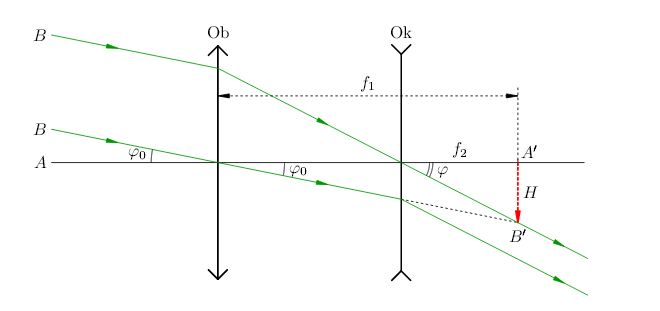 |
| Rice. 5. |
OPTICAL INSTRUMENTS, devices in which the radiation of any region of the spectrum (ultraviolet, visible, infrared) is converted (transmitted, reflected, refracted, polarized). Paying tribute historical tradition, optical devices are usually called devices operating in visible light. During the initial assessment of the quality of the device, only its main characteristics are considered: the ability to concentrate radiation - luminosity; the ability to distinguish neighboring image details - resolving power; the ratio of the size of an object and its image is an increase. For many devices, the defining characteristic is the field of view - the angle at which one can see from the center of the device extreme points subject.
Resolving power.
The ability of the device to distinguish between two close points or lines is due to the wave nature of light. The numerical value of the resolving power, for example, of a lens system, depends on the ability of the designer to cope with lens aberrations and carefully center these lenses on the same optical axis. The theoretical limit of resolution of two adjacent image points is defined as the equality of the distance between their centers to the radius of the first dark ring of their diffraction pattern.
Increase.
If the object is long H perpendicular to the optical axis of the system, and the length of its image H΄, then the increase m is determined by the formula m = H΄/ H. The increase depends on the focal lengths and the relative position of the lenses; there are corresponding formulas to express this dependence. An important characteristic instruments for visual observation is the apparent magnification M. It is determined from the ratio of the size of the images of the object that are formed on the retina during direct observation of the object and its examination through the device. Usually visible increase M express the attitude M=tg b/tg a, where a is the angle at which an observer sees an object with the naked eye, and b- the angle at which the observer's eye sees the object through the device.
If you want to create a high-quality optical device, you should optimize the set of its main characteristics - luminosity, resolution and magnification. It is impossible to make a good, for example, a telescope, achieving only a large apparent magnification and leaving a small luminosity (aperture). It will have poor resolution, since it is directly dependent on the aperture.
The designs of optical devices are very diverse, and their features are dictated by the purpose of specific devices. But when translating any designed optical system into a finished optical-mechanical device, it is necessary to place all optical elements in strict accordance with the accepted scheme, securely fix them, ensure precise adjustment of the position of moving parts, and place diaphragms to eliminate the unwanted background of scattered radiation. It is often necessary to maintain the set values of temperature and humidity inside the device, to minimize vibrations, to normalize the distribution of weight, to ensure the removal of heat from lamps and other auxiliary electrical equipment. Value attached appearance instrument and ease of use.
Microscopes.
If we look through a positive (collecting) lens on an object located behind the lens no further than its focal point, then an enlarged imaginary image of the object is seen. Such a lens is a simple microscope and is called a loupe or magnifying glass. From the diagram in Fig. 1 you can determine the size of the enlarged image. When the eye is tuned to a parallel beam of light (the image of the object is indefinitely long distance, which means that the object is located in the focal plane of the lens), the apparent magnification M can be determined from the relation (Fig. 1):
M=tg b/tg a = (H/f)/(H/v) = v/f,
Telescopes.
The telescope magnifies the visible size of distant objects. The scheme of the simplest telescope includes two positive lenses (Fig. 2). Rays from a distant object, parallel to the axis of the telescope (rays a and c in fig. 2) are collected in the back focus of the first lens (objective). The second lens (eyepiece) is removed from the focal plane of the lens by its focal length, and the rays a and c exit it again parallel to the axis of the system. Some beam b, which does not come from those points of the object from which the rays came a and c, falls at an angle a to the telescope axis, passes through the front focus of the objective and after it goes parallel to the system axis. The eyepiece directs it into its back focus at an angle b. Since the distance from the front focus of the lens to the observer's eye is negligibly small compared to the distance to the object, then from the scheme of Fig. 2 you can get an expression for the apparent increase M telescope:
M=-tg b/tg a = -F/f or F/f).
The negative sign indicates that the image is upside down. In astronomical telescopes, it remains so; Terrestrial telescopes use an inverting system to view normal rather than inverted images. The inverting system may include additional lenses or, as in binoculars, prisms.
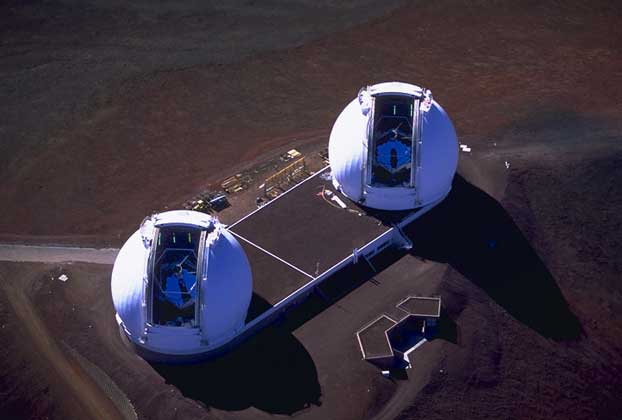
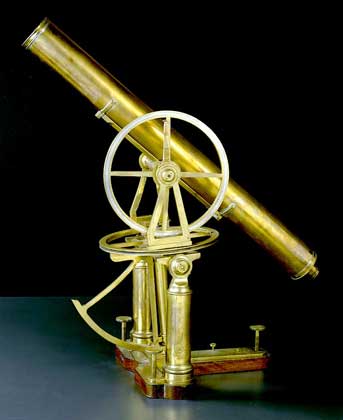

Binoculars.
A binocular telescope, commonly referred to as binoculars, is a compact instrument for observing with both eyes at the same time; its magnification is usually 6 to 10 times. Binoculars use a pair of turning systems (most often - Porro), each of which includes two rectangular prisms (with a base at 45 °), oriented towards the rectangular faces. In order to obtain high magnification in a wide field of view, free from lens aberrations, and therefore a significant field of view (6-9°), binoculars need a very high quality eyepiece, more advanced than a telescope with a narrow field of view. The eyepiece of the binoculars provides focusing of the image, and with vision correction - its scale is marked in diopters. In addition, in binoculars, the position of the eyepiece adjusts to the distance between the observer's eyes. Typically, binoculars are labeled according to their magnification (in multiples) and lens diameter (in millimeters), for example,
8'40 or 7'50.
![]()
Optical instruments help us explore the world. The telescope allows you to detect and examine the outlines and details of distant cosmic bodies, and the microscope reveals the secrets of our planet, such as the structure of living cells.
Our eyes are essentially optical instruments. When we look at an object, the lens system located in front of each eye forms its image on the retina - the fundus layer containing approximately 125 million light-sensitive cells. Light falling on the retina causes the cells to send an electrical nerve signal to the brain, allowing us to visually perceive the object.
In addition, the eyes have a brightness adjustment system. In bright light, the pupil instinctively constricts, reducing the brightness of the image to an acceptable level. In low light, the pupil expands, increasing the brightness of the image.
How the lens works
The lens system of the eye consists of a convex lens of the lens and a curved membrane in front of it filled with liquid, which is called the cornea. The cornea provides four-fifths of the entire focusing process. Fine adjustment is carried out by the lens, whose surface curvature is changed by the muscular ring (capsule) located around it. When the eye is unable to take the desired shape, usually due to disorders in these muscles, images of visible objects become blurry.
The most common visual impairment is the inability to focus on the retina of the image. individual items. If the lens system of the eye is too strong, in other words, if it is very convex, then distant objects will blur, and close ones will give clear images. People with this disorder are called nearsighted. If the convexity of the lens is insufficient, then close objects will blur, and images of distant objects will remain clear. Those with this vision are called farsighted. Both disorders can be corrected by using glasses or contact lenses. Nearsighted people wear glasses with concave lenses (thinner in the middle) that allow their eyes to focus on distant objects. Farsighted people wear glasses with convex lenses (thick in the center).
Increase
Strong convex lenses are often used as magnifying glasses. The first magnifying devices were used about 2000 years ago. Ancient Greek and Roman documents describe how a round glass vessel filled with water can be used to magnify objects. Lenses made entirely of glass appeared much later and were probably first used in the 11th century by monks working on manuscripts. At the end of the 13th century, magnifying glasses with low magnification were already used in glasses to correct farsightedness. But the technique of making concave lenses to correct myopia was not invented until the early 15th century.
telescopes
When magnifying glasses appeared, people naturally tried to use two such glasses instead of one in order to get even greater magnification. Experimentally, it was found that at a certain distance between the lenses, a distant object can be seen with a significant increase. This arrangement of lenses served as the basis for the creation of the first telescope, which at that time was called a spotting scope. The invention of this device is sometimes attributed to the English philosopher and naturalist Roger Bacon who lived in the 13th century. But perhaps the palm belongs to Arab scientists.
Galilean refractor
The spotting scope, created in 1608 by the Dutch optician Hans Lippershey, attracted the attention of the Italian scientist Galileo. Within a short time, the scientist improved Lippershey's design and created several pipes with improved characteristics. With their help, he made a number of discoveries, including mountains and valleys on the Moon, as well as four satellites of Jupiter.
Galileo's discoveries showed the importance of the telescope, and the type of instrument he used became known as the Galilean telescope. The convex lens of his objective collected light from the observed object. And the concave lens of the eyepiece deflected the light rays in such a way that they created an enlarged direct image. The lenses were mounted in tubes, one of which (smaller diameter) slid inside the other. This made it possible to adjust the distance between the lenses, while obtaining a clear image.
Optical instruments help us explore the world around us. The telescope allows you to detect and examine the outlines and details of distant cosmic bodies, and the microscope reveals the secrets of our planet, such as the structure of living cells.
Our eyes are essentially optical instruments. When we look at an object, the lens system located in front of each eye forms its image on the retina - the fundus layer containing approximately 125 million light-sensitive cells. Light falling on the retina causes the cells to send an electrical nerve signal to the brain, allowing us to visually perceive the object.
In addition, the eyes have a brightness adjustment system. In bright light, the pupil instinctively constricts, reducing the brightness of the image to an acceptable level. In low light, the pupil expands, increasing the brightness of the image.
How the lens works
The lens system of the eye consists of a convex lens of the lens and a curved membrane in front of it filled with liquid, which is called the cornea. The cornea provides four-fifths of the entire focusing process. Fine adjustment is carried out by the lens, whose surface curvature is changed by the muscular ring (capsule) located around it. When the eye is unable to take the desired shape, usually due to disorders in these muscles, images of visible objects become blurry.
The most common visual impairment is the inability to focus images of individual objects on the retina. If the lens system of the eye is too strong, in other words, if it is very convex, then distant objects will blur, and close ones will give clear images. People with this disorder are called nearsighted. If the convexity of the lens is insufficient, then close objects will blur, and images of distant objects will remain clear. Those with this vision are called farsighted. Both disorders can be corrected by using glasses or contact lenses. Nearsighted people wear glasses with concave lenses (thinner in the middle) that allow their eyes to focus on distant objects. Farsighted people wear glasses with convex lenses (thick in the center).
Increase
Strong convex lenses are often used as magnifying glasses. The first magnifying devices were used about 2000 years ago. Ancient Greek and Roman documents describe how a round glass vessel filled with water can be used to magnify objects. Lenses made entirely of glass appeared much later and were probably first used in the 11th century by monks working on manuscripts. At the end of the 13th century, magnifying glasses with low magnification were already used in glasses to correct farsightedness. But the technique of making concave lenses to correct myopia was not invented until the early 15th century.
telescopes
When magnifying glasses appeared, people naturally tried to use two such glasses instead of one in order to get even greater magnification. Experimentally, it was found that at a certain distance between the lenses, a distant object can be seen with a significant increase. This arrangement of lenses served as the basis for the creation of the first telescope, which at that time was called a spotting scope. The invention of this device is sometimes attributed to the English philosopher and naturalist Roger Bacon who lived in the 13th century. But perhaps the palm belongs to Arab scientists.
Galilean refractor
The spotting scope, created in 1608 by the Dutch optician Hans Lippershey, attracted the attention of the Italian scientist Galileo. Within a short time, the scientist improved Lippershey's design and created several pipes with improved characteristics. With their help, he made a number of discoveries, including mountains and valleys on the Moon, as well as four satellites of Jupiter.
Galileo's discoveries showed the importance of the telescope, and the type of instrument he used became known as the Galilean telescope. The convex lens of his objective collected light from the observed object. And the concave lens of the eyepiece deflected the light rays in such a way that they created an enlarged direct image. The lenses were mounted in tubes, one of which (smaller diameter) slid inside the other. This made it possible to adjust the distance between the lenses, while obtaining a clear image.
Galileo's telescope works using the principle of refraction (deflection) of light and is therefore also known as a refractor telescope. Another type of refractor telescope is characterized by the convexity of both lenses. This design creates an enlarged but inverted image and is known as an astronomical telescope.
Newton reflector
One major problem with early refracting telescopes was a lens defect called chromatic aberration that caused unwanted color halos around images. To remedy this shortcoming, English scientist Isaac Newton designed the reflecting telescope in the 1660s. To concentrate light rays and create an image, a concave mirror is used instead of an objective lens, which does not form color halos. A flat mirror reflects light into a convex eyepiece lens mounted on the side of the main tube. An instrument of this type is known as a Newtonian telescope.
microscopes
Magnifying glass sometimes called simple microscope, since it is used when observing small objects.
A compound microscope consists of two convex lenses. The objective lens creates a magnified image, which is then magnified again by the eyepiece lens. As with an astronomical telescope, this image is reversed. Many compound microscopes have a set of objective lenses with varying degrees of magnification.
- Burns, Robert - short biography
- The concept of common vocabulary and vocabulary of limited use
- Nancy Drew: The Captive Curse Walkthrough Nancy Drew Curse of Blackmoore Manor Walkthrough
- Deadpool - Troubleshooting
- Won't start How to Survive?
- What to do if bioshock infinite won't start
- Walkthrough Nancy Drew: Alibi in Ashes
- Spec Ops: The Line - game review, review Spec ops the line crashes on missions
- Room escape level 1 walkthrough
- Processing tomatoes with boric acid How much will 2 grams of boric acid
- Cucumber Grass (Borago)
- Bioinsecticide Lepidocid: purpose, properties and application procedure Lepidocide waiting period
- How to change the language to Russian in steam
- Dendrobium noble: room care
- Morphology of plants general concepts - document
- Planting, propagation and care of bamboo at home, photo Growing bamboo from seeds
- How to strengthen the cellular signal for the Internet in the country
- Sanskrit reveals the forgotten meaning of Russian words (2 photos)
- The oldest language Sanskrit programming language of the future Dead language Sanskrit
- Who has dominion over all the earth?









